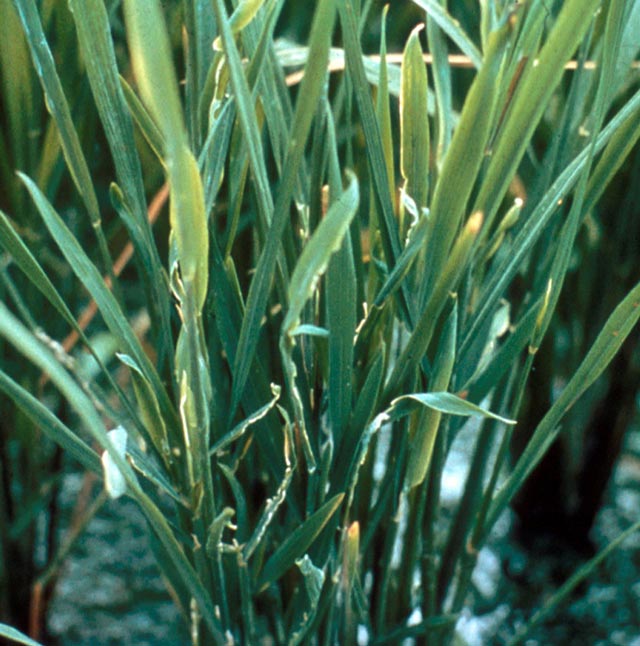Rice ragged stunt
 What it does
What it does
Rice ragged stunt virus reduces yield by causing partially exerted panicles, unfilled grains and plant density loss. It is vector-transmitted from one plant to another by brown plant hoppers. Leaves of infected plants have a ragged appearance.
Why and where it occurs
Rice ragged stunt virus infection is particularly high in tropical conditions where rice is planted all-year-around and provides a continuous host for the brown plant hopper vector.
The early instar nymphs of brown plant hoppers are more efficient transmitters of rice ragged stunt virus than brown plant hoppers at older stages. Brown plant hoppers contract the virus within 24 hours of feeding on an infected plant. They can transmit the virus to other plants after 6 hours of being infected with it and will remain infective for life. The virus is not transmitted via the brown plant hopper eggs. Infected stubble and volunteer rice are sources of rice grassy stunt virus.
If plants are infected at seedling stage, they develop new leaves with symptoms two weeks after inoculation. Leaves developed after this and until heading will show only mild or no symptoms. From heading onwards infected plants show symptoms again on the upper leaves and flag leaves.
 Twisted leaf caused by rice ragged stunt virus
Twisted leaf caused by rice ragged stunt virus
How to identify
To detect rice ragged stunt virus, check plants for:
- severe stunting during early crop stages
- green leaves with darker than normal color
- leaves with serrated uneven edges
- leaves appearing yellow to yellow-brown and twisted into
- spiral shapes at the base of leaf blades
- swollen, pale yellow or white to dark brown veins developing on leaf blades and sheaths
- galls on the underside of leaf blades and outer surface of leaf sheaths
- twisted, malformed flag leaves that are shortened at booting stage
- delayed flowering
- incomplete panicle emergence
- nodal branches forming at the upper nodes
- partially exerted panicles and unfilled grains
The ragged appearance and twisted leaf symptoms can be confused with the damage caused by rice whorl maggot and nematodes. To confirm rice grassy stunt check for the presence of the brown planthopper vector, vein swelling and dark green color of leaves as well as severe stunting.
Why is it important
Rice ragged stunt virus can affect up to 75% of plants in a crop. Depending on the extent of the damage infected plants will either produce partially exerted panicles and unfilled grains or produce few or no grains. Infected crops will suffer significant yield losses of up to 80%.
How to manage
Preventive measures are more efficient against rice ragged stunt virus than direct-control measures. Once infected by the virus, a rice plant cannot be cured.
- Plant varieties resistant to brown planthopper.
Using resistant varieties for ragged stunt management is probably the most important control measure. Contact your local agriculture office for up-to-date lists of varieties available. - Practice synchronized planting.
- Plow infected stubbles under the field after harvest to reduce the virus source.







